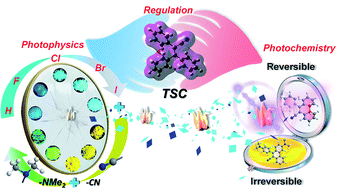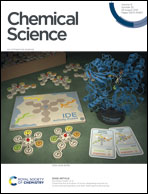Achieving highly efficient aggregation-induced emission, reversible and irreversible photochromism by heavy halogen-regulated photophysics and D–A molecular pattern-controlled photochemistry of through-space conjugated luminogens†
Abstract
It is extremely challenging but desirable to regulate the photophysical and photochemical processes of aggregation-induced emission luminogens (AIEgens) in distinct states in a controllable manner. Herein, we design two groups of AIEgens based on a triphenylacrylonitrile (TPAN) skeleton with through-space conjugation (TSC) property, demonstrate controlled regulation of photophysical emission efficiency/color and photochemical photochromic and photoactivatable fluorescence behaviours of these compounds, and further validate design principles to achieve highly efficient and emission-tuning AIEgens and to accomplish photo-dependent color switches and fluorescence changes. It is surprisingly found that the introduction of heavy halogens like bromine into a TPAN skeleton dramatically enhances the emission efficiency, and such an abnormal phenomenon against the heavy-atom effect is attributed to the specific through-space conjugation nature of the AIE-active skeleton, effective intermolecular halogen-bond-induced restriction of intramolecular motions, and heavy atom-induced vibration reduction. The incorporation of two electron-donating amino groups into the TPAN skeleton cause the luminogens to undergo a bathochromic shifted emission due to the formation of a D–A pattern. Apart from the regulation of photophysical processes in the solid state, the construction of the D–A pattern in luminogens also results in extremely different photochemical reactions accompanying reversible/irreversible photochromism and photoactivatable fluorescence phenomena in a dispersed state. It is revealed that photo-triggered cyclization and decyclization reactions dominantly contribute to reversible photochromism of the TPAN family, and the photo-induced cyclization–dehydrogenation reaction is responsible for the irreversible color changes and photoactivatable fluorescence behaviours of the NTPAN family. The demonstrations of multiple-mode signaling in photoswitchable patterning and information encryption highlight the importance of controlled regulation of photophysics and photochemistry of fused chromic and AIE-active luminogens in distinct states.



 Please wait while we load your content...
Please wait while we load your content...